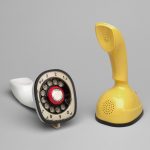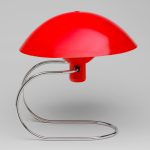Beyond simply defining and acknowledging the importance of design in our everyday lives, the The Museum of Modern Art’s (MoMA) The Value of Good Design exhibit explores the powerful democratizing potential of design.
“Good Design” reflects its specific place in time and questions to what extent consumer tastes and fads are influenced by the many underlying factors that come into play when designing a product, like the product’s function, how it was manufactured, who built it, and on. Such weighty questions are posited alongside pleasurable products such as a mass-market Italian Fiat Cinquecento, a bright yellow L.M. Ericsson telephone, and a red Irwin Gershwin shrimp cleaner. The exhibit leaves visitors with the question of whether midcentury values can be redefined and relevant for a modern audience. We think the answer is “absolutely.”
Inhabit spoke to the exhibit curators, Juliet Kinchin and Andrew Gardner, to find out more about the inspiration for the exhibit, why it is important now and what items to keep an eye out for.
What was the inspiration for the exhibit?
The Useful Objects (1938-1948) and Good Design (1950-55) exhibition series, along with a series of product and furniture design competitions in the 1940s and ’50s, were foundational in the history of this institution and form the basis of our rich holdings of design objects. The Value of Good Design was conceived of as a way to tell the story of MoMA’s involvement in championing industrial design in this period, but also to suggest the international constellation of similar programs in countries around the world, like Formes Utiles in France, the São Paulo Biennial in Brazil, and Die Gute Form in Switzerland. We will be exploring the vast interconnected network of industrial designers who were participating in these exhibitions and how their ideas and work were circulating in this period, both here at MoMA and around the world.
How long was the planning for the exhibit?
This has been an ongoing research project, one that was first addressed in 2009’s What Was Good Design? In light of a range of recent acquisitions that further illuminate the Good Design ethos of the midcentury period, we thought it was time to do a more comprehensive exploration of the topic and have been finalizing the checklist for the last several months.
How do you define “Good Design”?
One of the things we most hope to draw out in this exhibition is the varying perspectives that constituted a view of “Good Design” at midcentury. Edgar Kaufmann, who directed the Good Design exhibitions here at MoMA in the early 1950s, saw good design as a merging of form and function, but went further to suggest that it constituted “an awareness of human values expressed in relation to industrial production for a democratic society.” He also claimed that MoMA’s promotion of Good Design was not meant to set up “eternal values,” acknowledging that a well-designed product at one moment may appear differently the next. Good Design is a reflection of its time, one we continue to grapple with in a consumerist society easily tempted by trends and fads. Today, I would say the best designs are the ones that are chiefly guided by their functional purpose, but also grapple with issues of labor and sustainability. A design can be beautiful in its form and function, but if it is made by employing questionable labor practices or by utilizing environmentally destructive production practices, then it’s not a good design.
Why do you think this exhibit is important for this specific moment in time?
MoMA’s traveling exhibitions of American design at midcentury served as an extension of the aims of the U.S. State Department—namely, to spread the message of American economic ingenuity and progress to audiences around the world, to places in Europe, Asia and across North America. The United States was mired in a campaign of goodwill and peacekeeping, competing with the Soviet Union for dominance at a time of increased tensions between the forces of capitalism and communism. What the exhibition aims to raise is just how important these tools of “soft power” were in promoting economic development in a world still reeling from the ravages of World War II. It reminds us that we should not lose sight of the important role of diplomatic engagement, both at home and abroad, but also of the role that cultural institutions play in advancing this message around the world.
Can you highlight 2 or 3 items on view that really speak for the exhibit?
The Fiat 500, affectionately known as the Cinquecento, will be on view for the first time here at MoMA since we acquired it last year. It’s the car that really made car ownership accessible to the vast majority of Italian consumers in the postwar period. Another favorite is a 1951 textile designed by Joel Robinson, the first black designer represented in MoMA’s collection. Finally, the classic La Chaise chair by Charles and Ray Eames, which was designed for MoMA’s International Competition for Low Cost Furniture in 1948. Considered at the time “too specialized in use,” it finally went into production in the 1990s and today retails for nearly $13,000!
“The Value of Good Design” runs from February 10 to May 27. The Museum of Modern Art is located at 18 West 54th Street in Midtown West. The museum is open seven days: Saturday through Thursday, 10:30 a.m. to 5:30 p.m.; Fridays until 8 p.m. Admission: $25 for adults, $18 for seniors, $14 for full-time students with I.D.; free for children under 16. Admission is free for all visitors between 4 p.m. and 8 p.m. on Fridays. For more information, visit moma.org or call (212) 708-9400.








